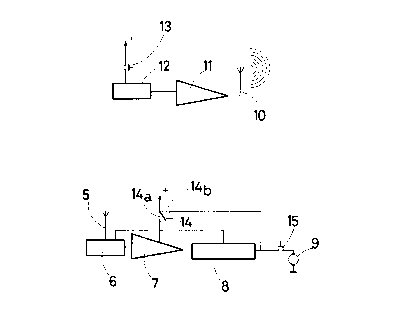Une partie des informations de ce site Web a été fournie par des sources externes. Le gouvernement du Canada n'assume aucune responsabilité concernant la précision, l'actualité ou la fiabilité des informations fournies par les sources externes. Les utilisateurs qui désirent employer cette information devraient consulter directement la source des informations. Le contenu fourni par les sources externes n'est pas assujetti aux exigences sur les langues officielles, la protection des renseignements personnels et l'accessibilité.
L'apparition de différences dans le texte et l'image des Revendications et de l'Abrégé dépend du moment auquel le document est publié. Les textes des Revendications et de l'Abrégé sont affichés :
| (12) Brevet: | (11) CA 2111285 |
|---|---|
| (54) Titre français: | VEHICULE JOUET POUR ENFANT MUNI D'UN DISPOSITIF DE SECURITE |
| (54) Titre anglais: | CHILD'S TOY VEHICLE HAVING A SAFETY DEVICE |
| Statut: | Périmé et au-delà du délai pour l’annulation |
| (51) Classification internationale des brevets (CIB): |
|
|---|---|
| (72) Inventeurs : |
|
| (73) Titulaires : |
|
| (71) Demandeurs : |
|
| (74) Agent: | SMART & BIGGAR LP |
| (74) Co-agent: | |
| (45) Délivré: | 1997-09-09 |
| (22) Date de dépôt: | 1993-12-13 |
| (41) Mise à la disponibilité du public: | 1995-06-14 |
| Requête d'examen: | 1993-12-13 |
| Licence disponible: | S.O. |
| Cédé au domaine public: | S.O. |
| (25) Langue des documents déposés: | Anglais |
| Traité de coopération en matière de brevets (PCT): | Non |
|---|
| (30) Données de priorité de la demande: | S.O. |
|---|
a présente invention vise un véhicule (1) doté d'un circuit récepteur qui peut être activé par le signal électromagnétique émis par une télécommande (17) manipulée par un adulte, et par un bouton-poussoir (15), monté en série avec le moteur (19), devant être actionné par l'enfant qui conduit le véhicule. Un interrupteur (14) désactive le circuit récepteur en coupant l'alimentation à celui-ci en même temps qu'il crée un pont entre l'alimentation et le bouton-poussoir (15) actionné par l'enfant. L'invention peut s'appliquer à des véhicules de jeu conduits par de très jeunes enfants, un adulte pouvant, à distance, couper l'alimentation du moteur pour arrêter le véhicule à n'importe quel moment, à des fins de sécurité.
It comprises a vehicle (1) including a receiver circuit
which may be enabled by the electromagnetic signal
emitted by a remote control (17), handled by an adult,
and a pushbutton (15), in series with the motor (19), to
be depressed by the child driving the vehicle. A switch
(14) breaks the supply to the receiver circuit, disabling
it, at the same time as it makes a bridge across the
power supply and the child operated pushbutton (15).
The invention is applicable to children's toy vehicles
driven by very young children, so that an adult located
remotely can break the motor supply to stop the vehicle
at any given time, for safety purposes.
Note : Les revendications sont présentées dans la langue officielle dans laquelle elles ont été soumises.
Note : Les descriptions sont présentées dans la langue officielle dans laquelle elles ont été soumises.

2024-08-01 : Dans le cadre de la transition vers les Brevets de nouvelle génération (BNG), la base de données sur les brevets canadiens (BDBC) contient désormais un Historique d'événement plus détaillé, qui reproduit le Journal des événements de notre nouvelle solution interne.
Veuillez noter que les événements débutant par « Inactive : » se réfèrent à des événements qui ne sont plus utilisés dans notre nouvelle solution interne.
Pour une meilleure compréhension de l'état de la demande ou brevet qui figure sur cette page, la rubrique Mise en garde , et les descriptions de Brevet , Historique d'événement , Taxes périodiques et Historique des paiements devraient être consultées.
| Description | Date |
|---|---|
| Inactive : CIB de MCD | 2006-03-11 |
| Inactive : CIB de MCD | 2006-03-11 |
| Inactive : CIB de MCD | 2006-03-11 |
| Inactive : CIB de MCD | 2006-03-11 |
| Le délai pour l'annulation est expiré | 1999-12-13 |
| Lettre envoyée | 1998-12-14 |
| Accordé par délivrance | 1997-09-09 |
| Inactive : CIB enlevée | 1997-08-07 |
| Inactive : CIB attribuée | 1997-08-07 |
| Inactive : CIB en 1re position | 1997-08-07 |
| Inactive : CIB attribuée | 1997-08-07 |
| Inactive : CIB enlevée | 1997-08-07 |
| Inactive : Dem. traitée sur TS dès date d'ent. journal | 1997-07-02 |
| Inactive : Renseign. sur l'état - Complets dès date d'ent. journ. | 1997-07-02 |
| Préoctroi | 1997-05-12 |
| Un avis d'acceptation est envoyé | 1996-11-12 |
| Demande publiée (accessible au public) | 1995-06-14 |
| Toutes les exigences pour l'examen - jugée conforme | 1993-12-13 |
| Exigences pour une requête d'examen - jugée conforme | 1993-12-13 |
Il n'y a pas d'historique d'abandonnement
| Type de taxes | Anniversaire | Échéance | Date payée |
|---|---|---|---|
| Taxe finale - petite | 1997-05-12 | ||
| Annulation de la péremption réputée | 1997-12-15 | 1997-11-18 | |
| TM (brevet, 4e anniv.) - petite | 1997-12-15 | 1997-11-18 |
Les titulaires actuels et antérieures au dossier sont affichés en ordre alphabétique.
| Titulaires actuels au dossier |
|---|
| JOSE MANUEL RODRIGUEZ-FERRE |
| Titulaires antérieures au dossier |
|---|
| S.O. |